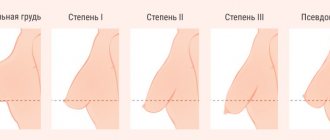Degrees of mastoptosis
Ptosis (mastoptosis) of the mammary glands is sagging of the breasts due to loss of elasticity and firmness, as well as a number of other reasons.
First of all, this is an aesthetic problem, which sometimes becomes psychological, as the woman begins to feel embarrassed about her body. This defect often occurs in girls. There are several degrees of mastoptosis. Normally, the nipple is located 5-7 cm above the inframammary fold located under the breast. Depending on the prolapse of the nipple, there are 3 degrees of ptosis:
- I - the nipple is lowered to the level of the pectoral fold, the sagging is unnoticeable;
- II - the nipple is located below the inframammary fold, ptosis is noticeable;
- III - the nipple is directed downwards, the sagging of the breast from the inframammary fold is more than 5 cm, pronounced.
In addition to the described degrees, pseudoptosis is also distinguished, in which the mammary glands sag, but the nipple is located above the fold. This type is typical for those with large breasts.
The presence of sagging is quite simple to determine: you need to place a pencil under the chest. If the mammary gland is of normal shape, the pencil falls off. If it persists, then we can talk about mastoptosis. To determine the degree of sagging, a measuring tape is needed to measure the distance from the nipple to the breast fold.
Dissatisfaction with the shape of women's breasts often becomes the cause of complexes and sometimes depression. Correction helps increase self-esteem and self-confidence, makes you feel attractive and young.
Additional breast support during breastfeeding - useful tips
During the daytime, it is recommended to wear a soft bra that fits snugly to the chest, but does not squeeze the mammary glands. When choosing underwear for sleep, bras with underwires or other additional inserts are excluded. The bra can be replaced with a comfortable top that also supports the breasts. During the day and at night, it is recommended to use special breast pads that will help keep your underwear clean. Otherwise, you need to change your night bra every day and then wash it.
The main causes of ptosis
There are many reasons why the mammary gland prolapses:
- hereditary factor;
- breast-feeding;
- age-related changes;
- fluctuations in body weight;
- changes in hormonal levels;
- macromastia and gigantomastia;
- smoking.
Let's look at each reason in more detail.
Breast-feeding
During pregnancy, the body prepares for childbirth and subsequent feeding of the child. Under the influence of hormones, the glands increase in size; when breastfeeding, they are filled with milk and increase in volume. After lactation, iron decreases, but stretched skin and ligaments can no longer return to their previous shape. The larger the breasts, and the longer the lactation period lasts, the more the mammary glands stretch.
Hereditary factor
The shape of a girl's breasts is largely determined by the elasticity of the skin and ligaments. This feature is determined by genetics, which is confirmed by many years of observation through family ties.
Age-related changes
Loss of elasticity in the skin and ligaments occurs with age. The body's production of collagen and elastin decreases, and the dermal framework becomes loose. The skin loses its elasticity and ability to support the weight of the glands. This primarily applies to large breasts.
Fluctuation in body weight
Breasts may sag if you gain excess weight. This happens because some of the fatty tissue is deposited in the breasts, its weight increases, and the skin stretches. Breasts can also sag after losing weight, when the fat layer decreases and excess skin forms, which causes ptosis.
Changes in hormonal levels
The glands enlarge even with minor hormonal changes, for example, before menstruation, but the breasts do not sag. Everything can change when serious hormonal disruptions occur in the body due to various endocrine diseases, which increase the risk of mastoptosis.
Gigantomastia
Large mammary glands have significant weight. The ligaments cannot constantly support such breasts; they lose elasticity and stretch over time.
Smoking
This habit, harmful to the body, increases the likelihood of mastoptosis, since nicotine inhibits the synthesis of elastin. The skin loses its elasticity and sags.
HOW TO RECOVER BREASTS
It is advisable to resort to surgical intervention to correct the shape of the mammary glands if there are the following indications:
- Breast ptosis, which is a condition where the breasts droop and sag. As a rule, this occurs after childbirth, sudden weight loss and with age due to weakness of the pectoral muscles and ligaments, stretching of the skin.
- asymmetry is a disproportion of the mammary glands, which consists in the fact that they have a difference in shape and/or size. This aesthetic defect can be either genetically determined or acquired (as a result of mechanical trauma, breastfeeding, implant displacement and other reasons).
- congenital breast pathology is an anomaly associated with a violation of the location and shape of the mammary gland, as well as the nipples and areola. Often the cause of the disease is intrauterine developmental defects. The most common types of pathology are tubular breasts, monomastia, micromastia and others.
- mastectomy is an operation that is performed when a patient is diagnosed with breast cancer. Surgery involves removing the breast.
- congenital underdevelopment of the breast - hypoplasia (lack of breast volume).
HOW TO RESTORATE BREASTS PHOTO
The photo gallery of the Abrielle plastic surgery clinic contains many photos before and after mammoplasty.
Prevention of ptosis
The appearance of mastoptosis can be prevented. There are several measures to prevent breast sagging:
- Properly selected underwear is a good preventive measure against breast cancer. .
- Play sports. Well-developed muscles of the back and chest support the mammary glands well, so choose those sports that develop these muscle groups well, for example, gymnastics and swimming.
- Take care of your breast skin using cosmetics that stimulate the synthesis of elastin and collagen.
- Watch your weight. Avoid sudden weight gain and loss.
- Take a contrast shower to stimulate blood supply to the skin.
If breast ptosis does occur, mastopexy will help restore the previous shape.
Additional recommendations
Lingerie
A well-fitting bra will help you get back into shape. It should be:
- with a tightening effect;
- corrective;
- to size;
- their natural fabrics;
- without overlays or push-ups.
When playing sports, you need to wear special bras to prevent injury.
Massage
After watching a training video, you can master the technique of manual massage, which will take only 5 minutes, but will have the desired effect. It tones the skin, improves blood circulation and lymph flow. If possible, it is better to make an appointment with a specialist.
At home, you can try water massage using a jet from the shower. The pressure should be moderate at first, but it can be increased each time. Alternate hot water with cold, but getting used to the temperature difference should be gradual.
Breast massage has several contraindications: lactation, oncology, implants, damage to the integrity of the skin, any rash on this area of the body.
other methods
To strengthen the pectoral muscles, you can also organize at home:
- dousing with cold water - twice a day;
- contrast compresses - every other day;
- rubbing with ice cubes - daily.
You don't need to try everything at once. Think about which methods you are more comfortable implementing. For example, not everyone can easily withstand wiping with ice. Start with less extreme and more enjoyable procedures.
To achieve good results in the shortest possible time, spend more time in the fresh air, finally quit smoking and work on your posture.
Preparing for surgery
The preparatory period for surgical intervention includes consultation with a plastic surgeon, mammologist, examination, examination, and tests.
Surgeon consultation
At the appointment, the plastic surgeon collects anamnesis, clarifies genetic factors, previous diseases, and allergies to medications.
During the examination, the doctor determines the size of the gland, the degree of ptosis, the ratio of adipose and glandular tissue, structural features of the breast, and the presence of stretch marks. Depending on the degree of mastoptosis, an intervention technique is selected and an operation plan is drawn up. The surgeon clarifies whether the patient plans to lose weight and advises doing so before surgery. In addition to the surgeon, you will need to consult a therapist, and additionally, if there are concomitant diseases, other specialists.
Analyzes
Before surgery, you must have the following tests:
- general blood analysis;
- Rh factor and group;
- coagulogram;
- blood biochemistry;
- blood for HIV (f. 50);
- blood for glucose;
- for hepatitis B (HbsAg) and C (HCV), for syphilis (RW);
- general urine analysis.
Examination and diagnosis
The doctor orders a breast examination. Up to 35 years of age, it includes one ultrasound or MRI procedure, and after 35, a mammogram and two ultrasound examinations are required. Patients with chronic diseases and over 40 are prescribed additional tests.
It is mandatory to do a FLG or chest x-ray, an electrocardiogram with a conclusion. A consultation with an oncologist/mammologist and a physician’s report are required.
Salon treatments
Plastic surgeons should be contacted only as a last resort, using all other available means. For example, if after losing weight your breasts have sagged too much and no creams can tighten them. Or if you want to increase it while maintaining a thin waist.
Breast myostimulation with electric current
For the first case, regular shape correction is suitable, which can be done using the following procedures:
- myostimulation with electric current;
- microcurrent therapy in combination with nourishing and moisturizing serums;
- mesotherapy, biorevitalization using hyaluronic acid;
- professional massage;
- salon masks (most often used with alginate and hyaluronic acid).
The second requires plastic surgery, when silicone implants are “sewn” into the chest. However, there is a safer alternative - lipofilling. It involves the introduction of adipose tissue taken from the thighs, buttocks or abdomen of the patient herself. Even after losing weight, it remains there, so you don’t have to worry about a lack of biomaterial.
Methods of performing the operation
Three main mastopexy techniques have been developed. The method of surgical intervention is chosen by the doctor. The method is determined by the degree of ptosis and the individual structure of the mammary gland.
Mastopexy is performed under general anesthesia. Anesthetics can be administered endotracheally or intravenously. The duration of the correction depends on the extent of the operation. If it is performed without endoprosthetics, it lasts from one and a half to three hours.
Periareolar
This type of technique is indicated only for stage I breast ptosis. The incision is made only around the circumference of the areola. During the operation, the glandular tissue is redistributed and the nipple and areola are moved slightly upward. The seam along the edge of the areola is almost invisible.
Vertical technique
It is used for stage II mastoptosis. The incision is made around the areola, then vertically down to the inframammary fold. The gland tissues are redistributed, raised to the upper pole and fixed. The nipple and areola are also tightened. The size of the areola can be reduced to improve the aesthetics of the breast.
Anchor (T-shaped) method
Performed for grade III ptosis. Before the operation, a marking is made along which the incision is made. The location of the nipple is determined.
The technique is considered classic, in which the incision is made in the shape of an anchor: first along the areola, then vertically down, then along the inframammary fold. During the operation, excess skin is also removed, the glandular and adipose tissue is shifted higher to the upper pole, fixed to the pectoral fascia, and the areola and nipple are moved.
Internal seams are made with absorbable threads. External tissues are sutured with polypropylene threads using a cosmetic suture. After 4 weeks they are removed. Drainage tubes are installed to remove serous fluid and blood. The drainage is usually removed the next day, sometimes a little later.
After the operation, compression garments and sometimes a bandage are worn, which relieves the stress on the sutures and supports the breast while healing.
Hand skin tightening after weight loss
Arm skin tightening or brachioplasty. The indication for it is severely sagging skin on the hands, which can be a consequence of sudden weight loss, a consequence of a decrease in muscle mass in former athletes who have stopped training, as well as a consequence of age-related changes in the skin, loss of elasticity and the appearance of ptosis.
Brachioplasty is not one of the complex plastic surgeries. It is performed over 2-2.5 hours under general anesthesia. The scar is located on the inside of the arm, running from the armpit down the forearm. The length of the scar depends on the amount of skin removed, but usually it ends a few centimeters above the level of the elbow. The scar is considered one of the biggest disadvantages of the procedure, as it is more difficult to hide than scars on the chest or abdomen. However, it is important to note that it is usually located in a natural depression of the skin, which is formed by the relief of the biceps of the arm, so it is sometimes not so easy to notice a completely healed scar.
Rehabilitation period, advice from a plastic surgeon
After the correction, we leave the patient in the hospital for two days, then she is transferred to outpatient treatment with constant monitoring. After 2-4 weeks, the hematomas disappear, after 5-7 days the pain disappears, and after one month physical activity is restored.
For better healing of sutures and restoration of the shape of the mammary glands, I recommend following some rules:
- To reduce pain, you need to take non-steroidal analgesics for the first four days.
- It is necessary to take antibiotics to prevent mastitis and suppuration of the sutures. The seams need to be treated with antiseptic ointment.
- To make the seams invisible, treat them with a special gel.
- You must wear compression garments for at least six weeks. It helps relieve swelling and reduces the likelihood of stitches coming apart. For the first five days you should always be in this underwear, then you can take it off for a while.
- I recommend using a silicone patch along with compression garments.
- You should avoid hot baths and saunas for two months. You can take a warm shower after 5 days, at which time you can remove the compression garments for a short time.
- Avoid injuries and pressure on the glands throughout the recovery period.
- Sleep on your back for the first month of rehabilitation.
- For the first six months, heavy physical activity and physical education are prohibited. Increase the loads gradually.
- To speed up recovery, use physiotherapeutic procedures, for example, magnetic therapy, which improves metabolic processes and lymphatic drainage.
Results will become visible after two to three months, but full recovery will occur within a year.
Medial thigh lift
As you lose weight, the volume of fatty tissue on your thighs decreases. The skin of their inner (medial) surface is thinner, so it sags, creating a cosmetic defect. To correct this deficiency, a thigh lift is used.
Operation technique
The incision is made from the groin to the gluteal fold. The skin flap from the inner surface of the thigh is peeled down 20 - 25 cm. The plastic surgeon pays special attention to the large vessels and nerve trunks passing in this area so as not to damage them. The skin is then pulled upward and the excess is excised. Special reinforcing sutures are applied to the wound. This is necessary to prevent relapse of the pathology.
Recovery period
To speed up skin recovery, the patient is recommended to use elastic bandages or compression garments. The use of these accessories prevents friction of postoperative areas and the formation of serous exudate (wound fluid).
During this operation, the suture is located in the groin area. This area is mobile, so healing of a postoperative wound takes longer than in other areas of the body. This requires increased attention from the surgeon.
Contraindications
Medial thigh lift is contraindicated in the following cases:
- concomitant cardiac or pulmonary failure;
- oncological diseases;
- diabetes, tuberculosis, immunodeficiency;
- inflammatory diseases of the skin of the lower extremities.
Effects
As a result of the intervention, the volume of the hips decreases, they become toned and elastic. The contour of the legs takes on a clear outline. To enhance the effect, the operation is combined with liposuction - removal of excess subcutaneous fat deposits.
Breast lift without surgery
Various procedures aimed at improving blood microcirculation, preserving and maintaining the elasticity of the skin and ligaments, and strengthening the muscles of the chest and back will help maintain the shape of the breast.
These include massage, which can be manual. Water or vacuum.
Physiotherapy procedures are considered safe and effective methods of tightening, such as:
- myostimulation;
- mesotherapy;
- biorevitalization;
- microcurrent.
Push-ups, palm rest, exercises with dumbbells and a punching bag will help strengthen your muscles.
To support the procedure, you can supplement with nutrients that stimulate blood circulation and elastin synthesis. These can be essential oils from plants such as ylang-ylang, grape seed, fennel, jojoba, hops, sage, geranium, hazel and others. To prevent women's breasts from sagging, cosmetic masks applied to the mammary glands give good results.
HOW TO RESTORATE BREASTS: CONTRAINDICATIONS
After breast surgery, whether it is changing the shape of the breast or correcting the location of the nipples, it is not possible to evaluate the result instantly. It is necessary to wait until the breast recovers and the traces of surgical intervention disappear or become almost invisible. The length of time required for this depends on the type of mammoplasty.
Gradually, the breasts will become soft and natural, taking on their final shape - attractive and seductive.
Before deciding how to surgically restore your breasts, you need to make sure that there are no following contraindications to surgery:
- decompensated diabetes;
- oncological diseases;
- bleeding disorders;
- period of pregnancy or lactation;
- age up to 18 years.
The famous TV presenter Masha Malinovskaya said after surgery to restore the mammary glands that her breasts had become so magnificent that she could tour separately. Her enthusiastic review of the mammoplasty performed is quite natural. After all, plastic surgery is a real chance for every woman to become the owner of a toned bust of the desired size. Virtuoso surgeons, like magicians, help their patients say goodbye to complexes forever and gain self-confidence.











